| Image | Document Title | Summary | Download Link | Resource Categories | resource_category_hfilter |
|---|---|---|---|---|---|
 | DIY guidelines for citzen science projects in odour-conflicted communities | These guidelines aim to support citizen science projects operating in odor-conflicted communities. They are DIY guidelines – helping you to “do it yourself”- and offer tested tools and practical tips for running projects and adapting them to different contexts. | DIY guidelines for citzen science projects in odour-conflicted communities
| Educational, Measuring | educational measuring |
 | Review on odour pollution and its relationship with chemical compounds and health issues | This document provides an overview of the chemical compounds in the odour emissions from different plants, with the purpose of identifying the most “critical” compounds from the point of view of their potential toxicity, and provide a list of those compounds, which should effectively be investigated more carefully during monitoring activities. The study was focused on those odour-emitting activities, which also typically cause worries related to potential health effects, i.e. foundries, landfills and refineries. | Review on odour pollution and its relationship with chemical compounds and health issues | Measuring, Research | measuring research |
 | Analysis of existing regulations in odour pollution, odour impact criteria 2 | This document provides an overview of odour regulations in several countries around the world | Analysis of existing regulations in odour pollution, odour impact criteria 2 | Regulations, Research | regulations research |
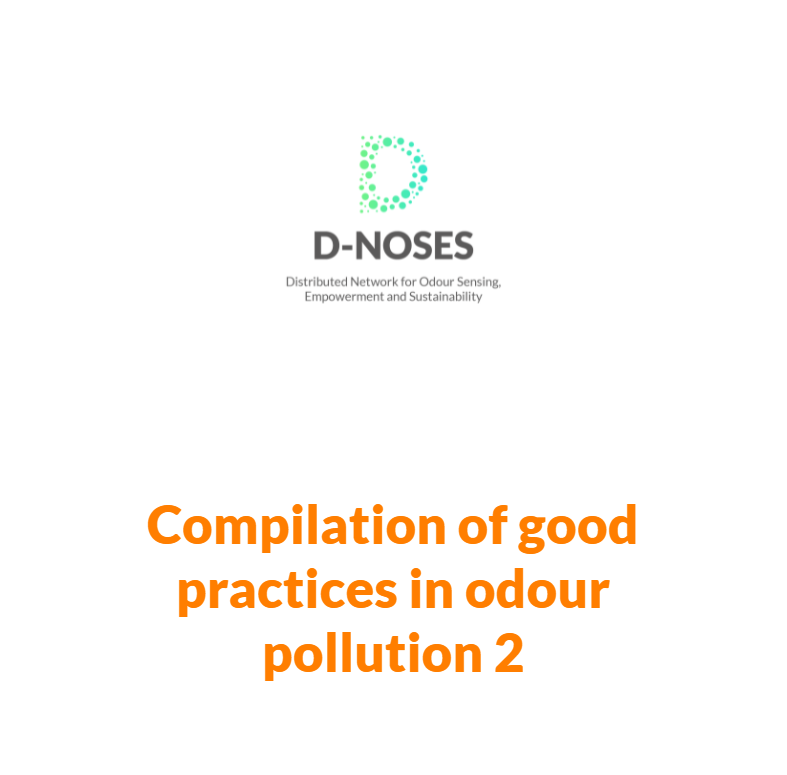 | Compilation of good practices in odour pollution 2 | One of the aims of the D-NOSES project is to promote good practices in odour pollution, led by quadruple helix actors, which can be used as positive examples for project replicability. As a first step, we decided to discuss the practices to manage odour emissions described in the Best Available Techniques (BAT) Reference Documents (BREF) documents. Such documents are not specific for odours; however, because odours are now recognized as atmospheric pollutants, most of the BREF documents published in recent years include specific reference to odour pollution and to techniques for the reduction of odour emissions. Moreover, we tried to collect some examples of real application of good practices from the Consortium partners. | Industry, Research | industry research | |
 | Strategic Roadmap for governance in odour pollution | The Roadmap for Governance in Odour Pollution positions objectives and strategies to pave the way for future regulations in odour pollution in the medium and long term. | Policies, Regulations | policies regulations | |
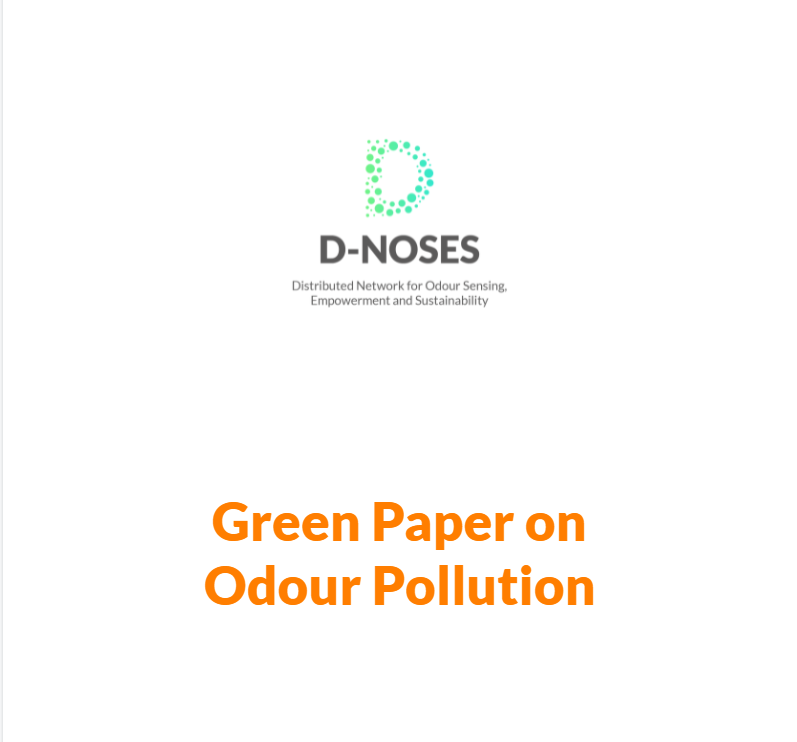 | Green Paper on Odour Pollution | The Green Paper on Odour Pollution is a policy document that aims to place odour pollution in the policy agendas by providing recommendations to better tackle the issue and move towards an improved regulatory framework in Europe. | Industry, Policies, Regulations | industry policies regulations | |
 | Standardizing the monitoring of odour pollution through citizen science: the experience in Spain | The D-NOSES project has been a great push to the methodologies for assessing odour impact, allowing to go beyond the state-of-the-art by introducing citizen science for real time monitoring from the receptors’ point of view. | Standardizing the monitoring of odour pollution through citizen science: the experience in Spain | Regulations | regulations |
 | The Multilevel engagement plan for stakeholders and communities | This document provides a preliminary mapping of communities affected by odour pollution in eight European countries and in Chile, and presents a conceptual framework for supporting stakeholders in planning and conducting citizen science interventions aimed at tackling odour problems. | Educational | educational | |
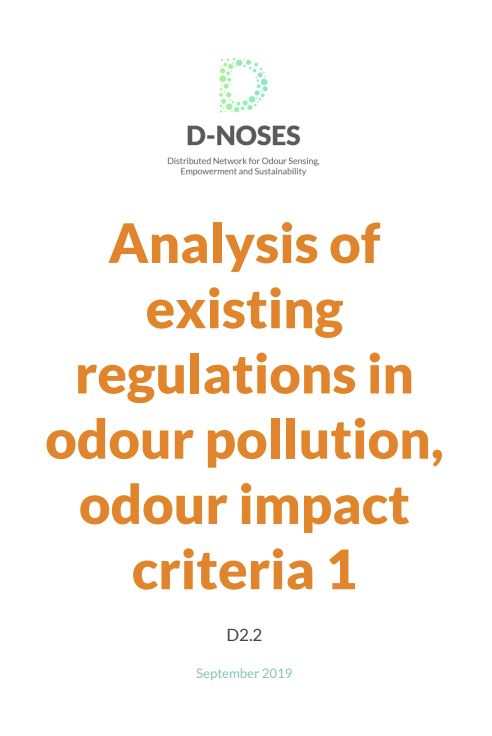 | The analysis of existing regulations in odour pollution and odour impact criteria | This document provides an overview of odour regulations in eight European countries and in Chile. | Regulations, Research | regulations research | |
 | The compilation of good practices in odour pollution | One of the aims of the D-NOSES project is to promote good practices in odour pollution, led by quadruple helix actors (i.e. promoted by citizens, administrations or industries that were able to solve the odour problem through different mechanisms in different contexts, increasing the level of sustainability), which can be used as positive examples for project replicability. Meanwhile, this document provides a summary of reference good practices for managing and controlling odour emissions as stated by the European Community in their Reference documents for Best Available Techniques in different sectors. | Measuring, Research | measuring research | |
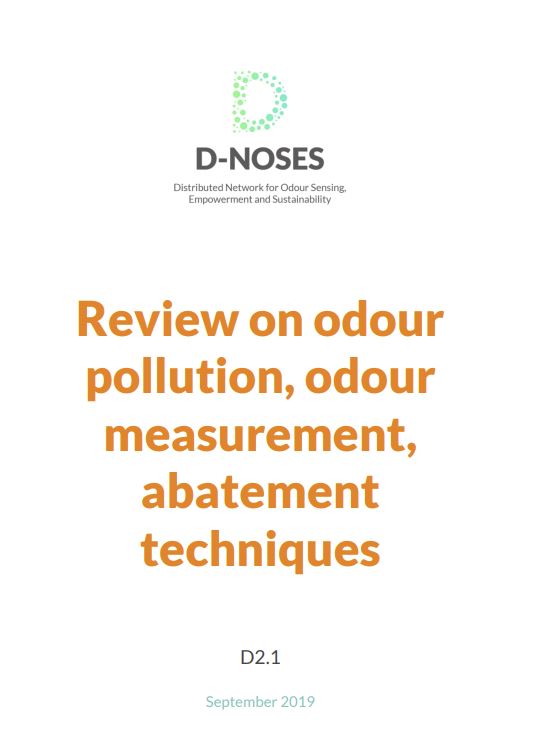 | Review on odour pollution, odour measurement, abatement techniques | In the frame of the D-NOSES project, in order to reach the goal of creating common scientific guidelines for policy making, it is extremely important to define the scientific framework of odour pollution, by answering fundamental questions about the nature of odour pollution, the ways to measure it, and the methods available to reduce odour impacts. This document provides an up-to-date review of the methods that can be used in order to measure odours and the techniques that can be adopted for odour emissions abatement. | Measuring, Research | measuring research | |
 | D-NOSES course on odour pollution (MOOC for educators) | The MOOC supports educators to introduce the topic to their target audiences, not only students but also learners in the wider sense, such as life-long learners, citizens, etc. Part I examines what generates odour pollution, its impacts -environmental, social, health and economic- and sheds light on the various D-NOSES resources and tools that can support citizens to address the problem. Part II presents a series of learning activities (by suggested age groups) that can be used by educators. | Educational | educational | |
 | Industry Toolkit | This industry guidance toolkit is aimed at all industrial sites, establishments, businesses and institutions which activities may emit odours. As an odour emitting stakeholder, you may hold an environmental regulatory permit which you must comply to, or you may simply want to be an exemplary neighbour to the communities located in the vicinity of your plant(s). This toolkit is designed to help you anticipate the odour impact that your activities may have on your neighbours. This toolkit walks you through the steps you need to take to establish an Odour Management Plan (OMP), which should help you comply with your environmental responsibilities and prevent conflict associated with odour nuisances.
| Industry | industry | |
 | Summary and Overview of the Odour Regulations Worldwide | This paper, published in 2021 after a work of 4 years, reviews and summarises the odour legislation in selected European countries, North America, and South America, as well as Oceania and Asia. Many countries have incorporated odour-related assessment criteria into their legislation. However, it tend to be highly variable between countries, individual states, provinces, and even counties and towns. | Regulations, Research | regulations research | |
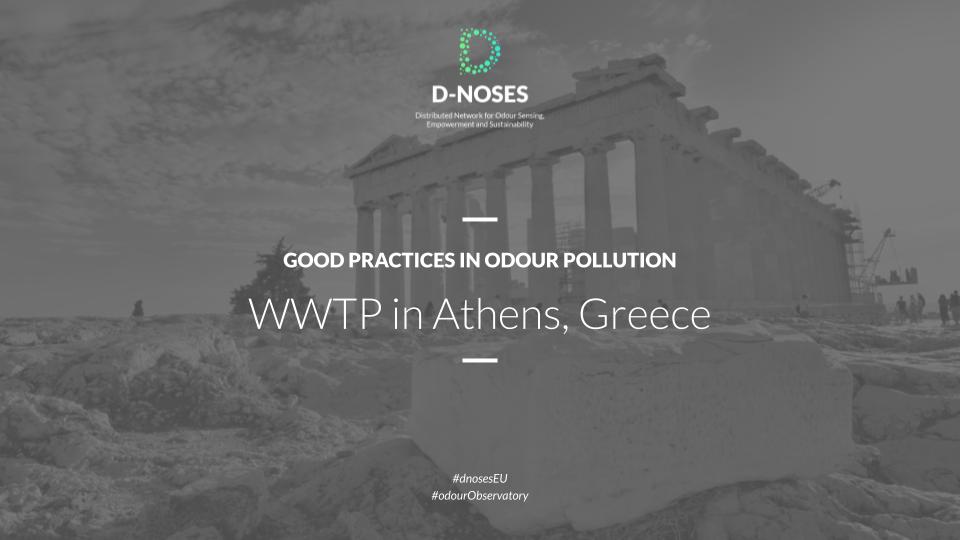 | Best Practices for Industries: Odour Reduction for a WWTP in Athens | D-NOSES partners provides best practices examples related to odour reduction processes to inspire industries. This case study looks at the odour reduction practices implemented in a wastewater treatment plant in Athens, which had emitted odours affecting surrounding communities for more than two decades. | Industry, Measuring, Regulations | industry measuring regulations | |
 | Best Practices for Industries: WWTP Design in Portugal | D-NOSES partners provides best practices examples related to odour reduction processes to inspire industries. This case study looks at how one can approach the design of a wastewater treatment plant in light of best practices related to odour minimisation in Portugal. | Industry, Measuring, Regulations | industry measuring regulations | |
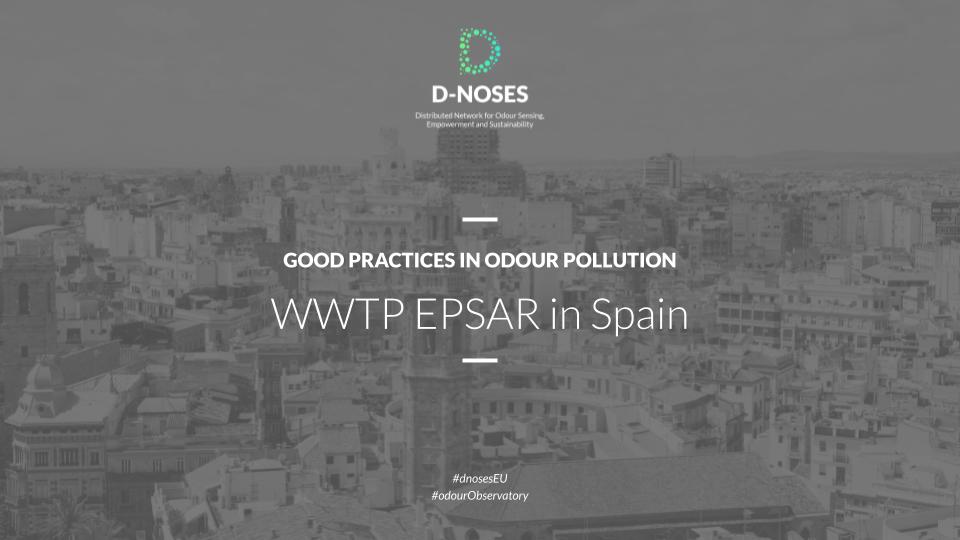 | Best Practices for Industries: Odour Reduction for a Spanish WWTP | D-NOSES partners provides best practices examples related to odour reduction processes to inspire industries. This case study looks at the odour reduction practices implemented by EPSAR (the Public Entity for the Sanitation of Wasterwater in the Community of Valencia, Spain) for one of its wasterwater treatment plant. | Industry, Measuring, Regulations | industry measuring regulations | |
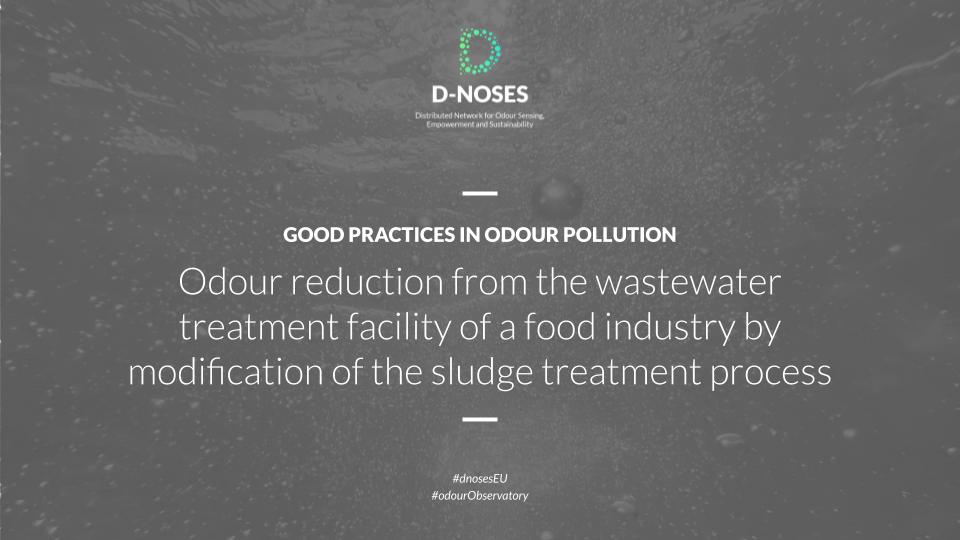 | Best Practice for Industries: Odour Reduction in a Food Industry WWTP | D-NOSES partners provides best practices examples related to odour reduction processes to inspire industries. This case study looks at odour reduction practices implemented by a food industry for one of its wastewater treatment facility, through the modification of the sludge treatment process. | Industry, Measuring, Regulations | industry measuring regulations | |
 | Overview of odour measurement methods: the OO as an informative tool for citizen science based approaches to odour management | This article introduces the D-NOSES project, its methodology and presents an overview of the existing odour impact assessment methods currently available to quantify odour pollution. | Research | research | |
 | D-Noses' Policy Brief Greek GR | The complexity of the odour pollution question can make it difficult for stakeholders to fully grasp the issues. To support local decision-makers, emitting industries, and affected citizens in understanding the key facts, D-NOSES has published a policy brief entitled “Odour pollution – A growing societal concern”. The aim is to give readers a short, four-page introduction to the issues and explain the practical value of the proposed D-NOSES solution. | Policies | policies | |
 | D-Noses' Policy Brief Bulgarian BG | The complexity of the odour pollution question can make it difficult for stakeholders to fully grasp the issues. To support local decision-makers, emitting industries, and affected citizens in understanding the key facts, D-NOSES has published a policy brief entitled “Odour pollution – A growing societal concern”. The aim is to give readers a short, four-page introduction to the issues and explain the practical value of the proposed D-NOSES solution. | Policies | policies | |
 | D-Noses' Policy Brief Portuguese PT | The complexity of the odour pollution question can make it difficult for stakeholders to fully grasp the issues. To support local decision-makers, emitting industries, and affected citizens in understanding the key facts, D-NOSES has published a policy brief entitled “Odour pollution – A growing societal concern”. The aim is to give readers a short, four-page introduction to the issues and explain the practical value of the proposed D-NOSES solution. | Policies | policies | |
 | D-Noses' Policy Brief French FR | The complexity of the odour pollution question can make it difficult for stakeholders to fully grasp the issues. To support local decision-makers, emitting industries, and affected citizens in understanding the key facts, D-NOSES has published a policy brief entitled “Odour pollution – A growing societal concern”. The aim is to give readers a short, four-page introduction to the issues and explain the practical value of the proposed D-NOSES solution. | Policies | policies | |
 | D-Noses' Policy Brief Spanish SP | The complexity of the odour pollution question can make it difficult for stakeholders to fully grasp the issues. To support local decision-makers, emitting industries, and affected citizens in understanding the key facts, D-NOSES has published a policy brief entitled “Odour pollution – A growing societal concern”. The aim is to give readers a short, four-page introduction to the issues and explain the practical value of the proposed D-NOSES solution. | Policies | policies | |
 | D-Noses' Policy Brief Italian IT | The complexity of the odour pollution question can make it difficult for stakeholders to fully grasp the issues. To support local decision-makers, emitting industries, and affected citizens in understanding the key facts, D-NOSES has published a policy brief entitled “Odour pollution – A growing societal concern”. The aim is to give readers a short, four-page introduction to the issues and explain the practical value of the proposed D-NOSES solution. | Policies | policies | |
 | D-Noses' Policy Brief German DE | The complexity of the odour pollution question can make it difficult for stakeholders to fully grasp the issues. To support local decision-makers, emitting industries, and affected citizens in understanding the key facts, D-NOSES has published a policy brief entitled “Odour pollution – A growing societal concern”. The aim is to give readers a short, four-page introduction to the issues and explain the practical value of the proposed D-NOSES solution | Policies | policies | |
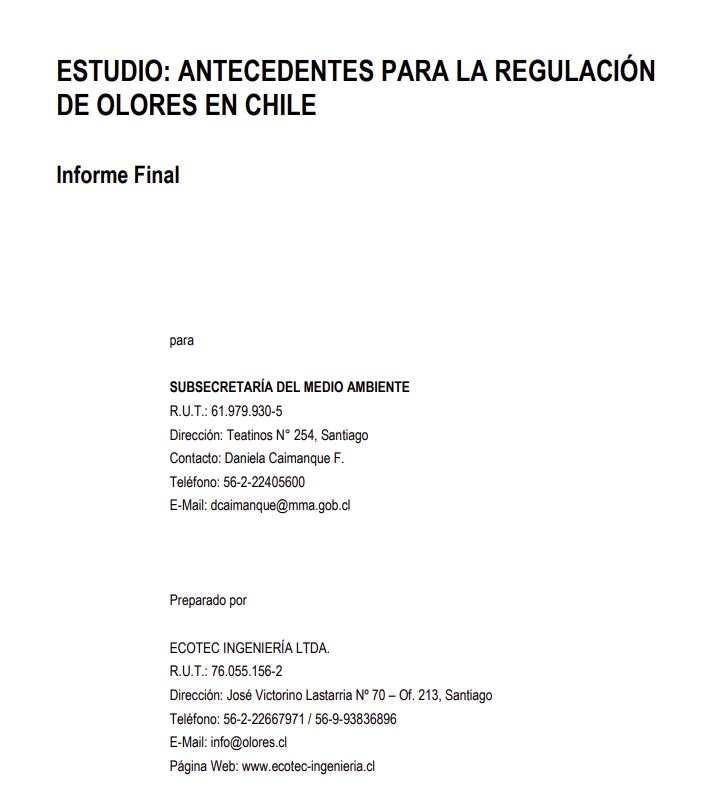 | Estudio: Antecedentes para la regulación de olores en Chile (in Spanish) | Report by ECOTEC about an odour regulation proposal for Chile, including an analysis of odours in the country and national/international regulations (in Spanish). | Regulations, Research | regulations research | |
 | Ministerio del Medio Ambiente Chile website (in Spanish) | Website dedicated to odours from the Chilean Ministry of Environment with detailed information about odours, regulations and measurements (in Spanish). | Educational, Measuring, Policies, Regulations, Research | educational measuring policies regulations research | |
 | Olores.org website | The site that deals with odour management, including news, specialised events, techniques and a directory companies dealing with environmental odour management (by Carlos Díaz). | Measuring, Policies, Regulations, Research | measuring policies regulations research | |
 | Citizen Science in odour monitoring | Introduction of the approach proposed by D-NOSES, which incorporates citizen science in odour monitoring (from the ‘Citizen Science for Environmental Monitoring in the UK‘ webinar by Mapping for Change). | Educational, Measuring | educational measuring | |
 | Citizen Science definition | Short video introducing the concept of citizen science, its relation to the SDGs and the different levels of engagement (from ‘Citizen Science for Environmental Monitoring in the UK‘ webinar by Mapping for Change). | Educational | educational | |
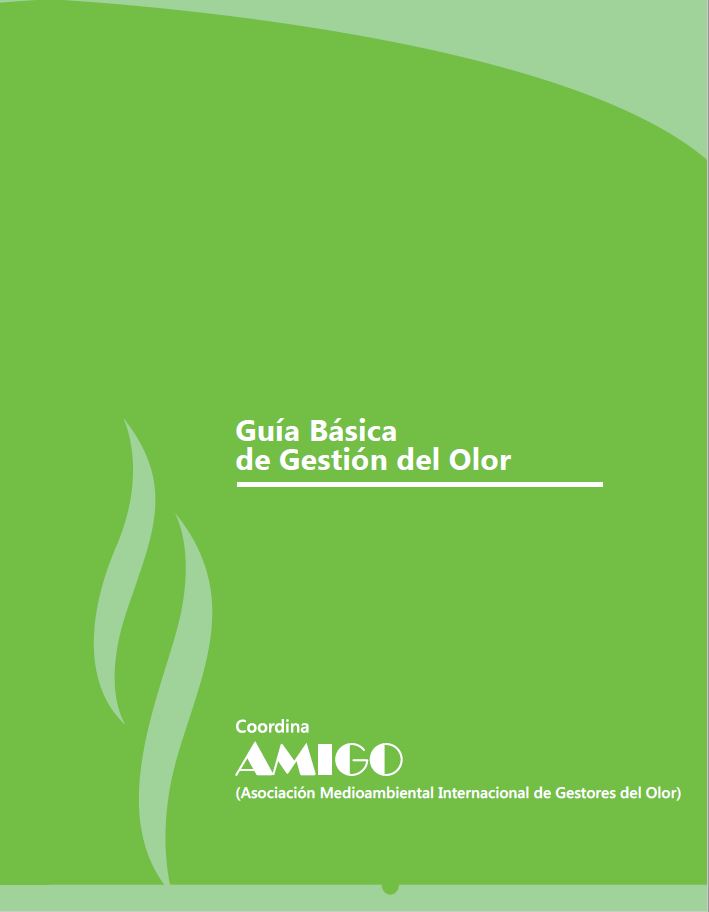 | Guía Básica de Gestión del Olor (in Spanish) | This guide contains the regulatory odour framework for Spain, Chile, Colombia and Argentina as well as odour evaluation, management and control. | Educational, Regulations | educational regulations | |
 | Regulación de olores en Colombia y España (in Spanish) | This webinar, organised by AMIGO, introduces the regulatory framework for odours in Spain (Antonio Amo, LABAQUA) and Colombia (Jaime Cardona, GSA S.A.S). | Regulations | regulations | |
 | Regulacion de olores Chile y Argentina (in Spanish) | This webinar, organised by AMIGO, introduces the regulatory framework for odours in Chile (Álvaro Ulloa) and Argentina (Analía Escribano). | Regulations | regulations | |
 | Introducción a la gestión y teoría del olor (in Spanish) | Introduction to odour theory and odour management (In Spanish), a webinar run by Cyntia izquierdo (olores.org) on 8th September 2020. | Educational | educational | |
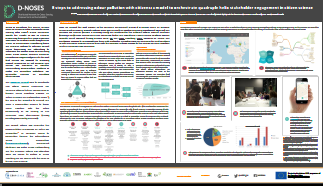 | D-NOSES Stakeholder Engagement Model | This poster describes the history behind the D-NOSES stakeholder engagement model and how it’s been applied so far in the Forum area of Barcelona. | Research | research | |
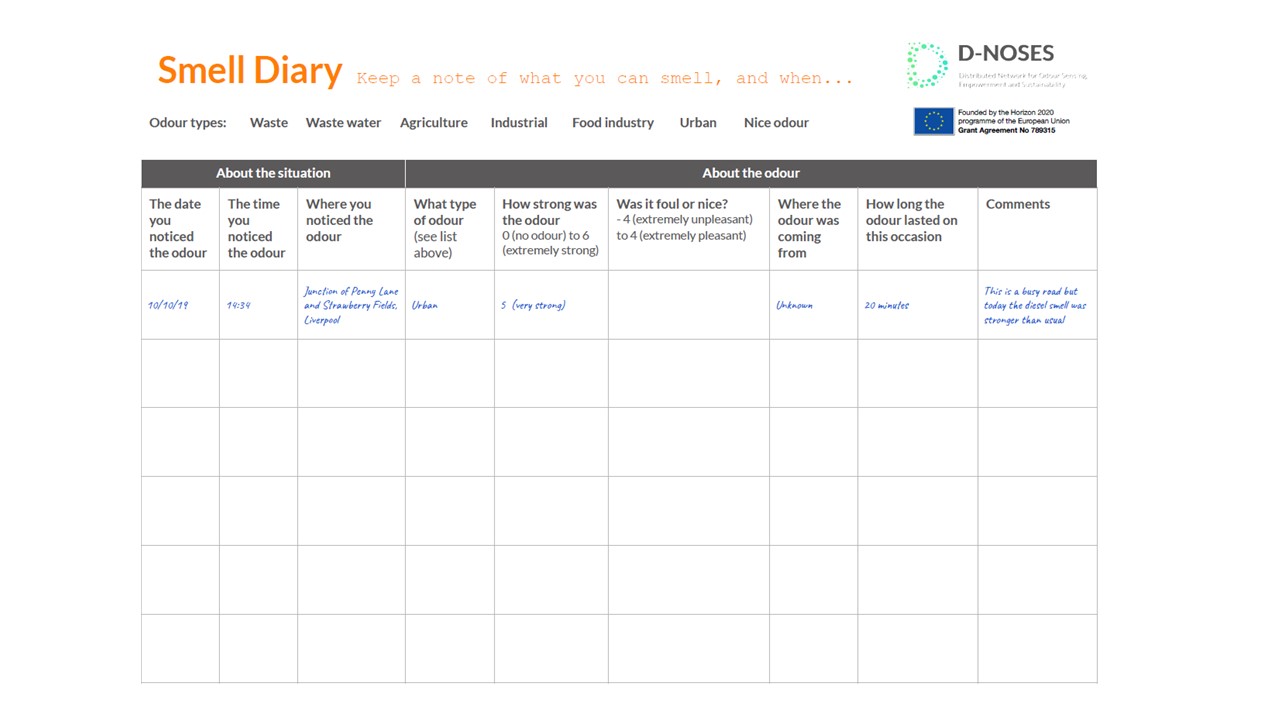 | Smell Diary Template | Use the form to record odour observations | Measuring | measuring | |
 | Non-Specific Chemical Analysis | This summary sheet explains the general role of non-specific chemical analysis in measuring odours. Simply put, it measures the concentration of hydrocarbons present in an air sample. | Educational, Measuring | educational measuring | |
 | D-Noses' Policy Brief | The complexity of the odour pollution question can make it difficult for stakeholders to fully grasp the issues. To support local decision-makers, emitting industries, and affected citizens in understanding the key facts, D-NOSES has published a policy brief entitled “Odour pollution – A growing societal concern”. The aim is to give readers a short, four-page introduction to the issues and explain the practical value of the proposed D-NOSES solution. This should raise awareness of odour pollution and provide all stakeholders with the necessary background knowledge to think about how they can engage in productive dialogues and effective co-created solutions. | Educational, Policies, Regulations | educational policies regulations | |
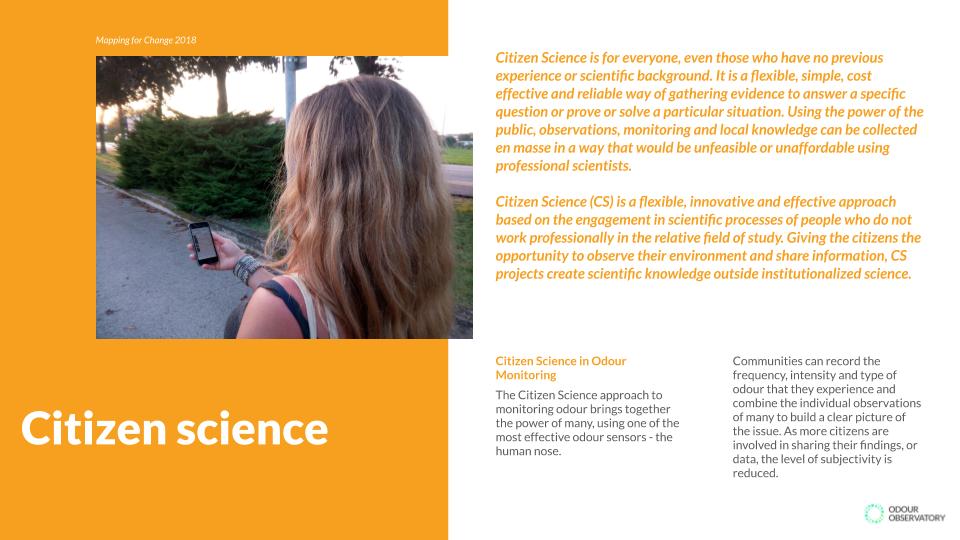 | Citizen Science | This summary sheet explains how citizen science can be used for the measurement of odours. | Educational, Measuring | educational measuring | |
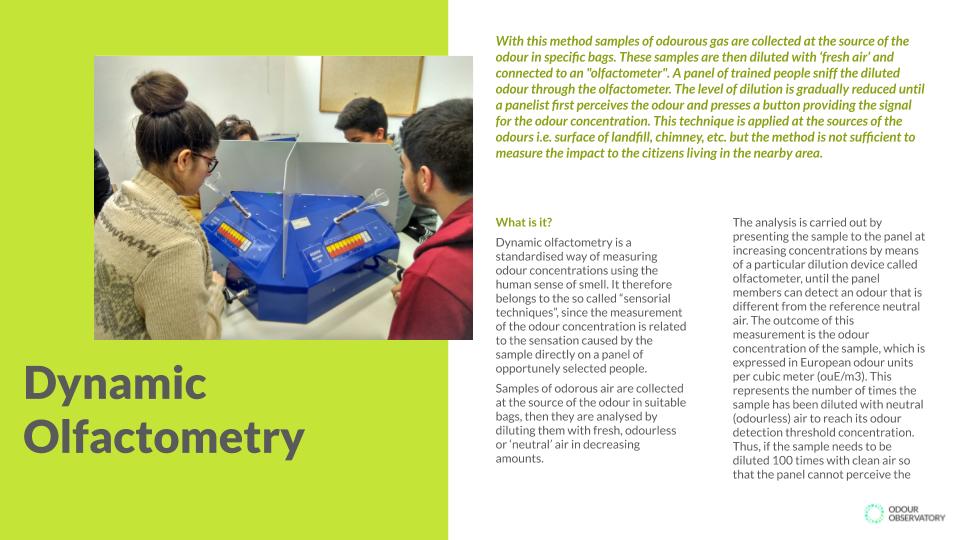 | Dynamic Olfactometry | This summary sheet explains the method of dynamic olfactometry in measuring odours. With this method, samples of odourous gas are collected at the source of the odour in specific bags. | Educational, Measuring | educational measuring | |
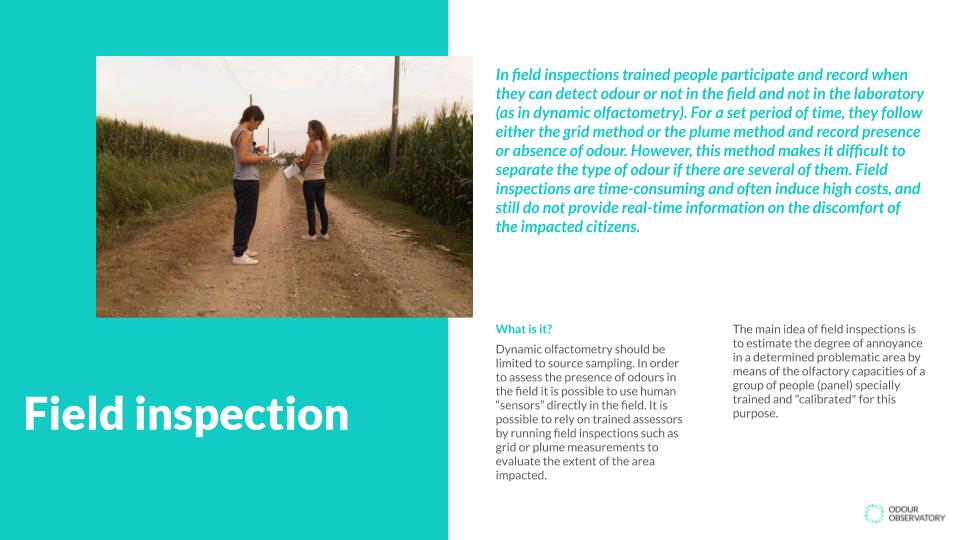 | Field Inspection | This summary sheet explains the method of field inspection in measuring odours. In field inspections, trained people participate and record when they can detect odour or not in the field and not in the laboratory (as in dynamic olfactometry). | Educational, Measuring | educational measuring | |
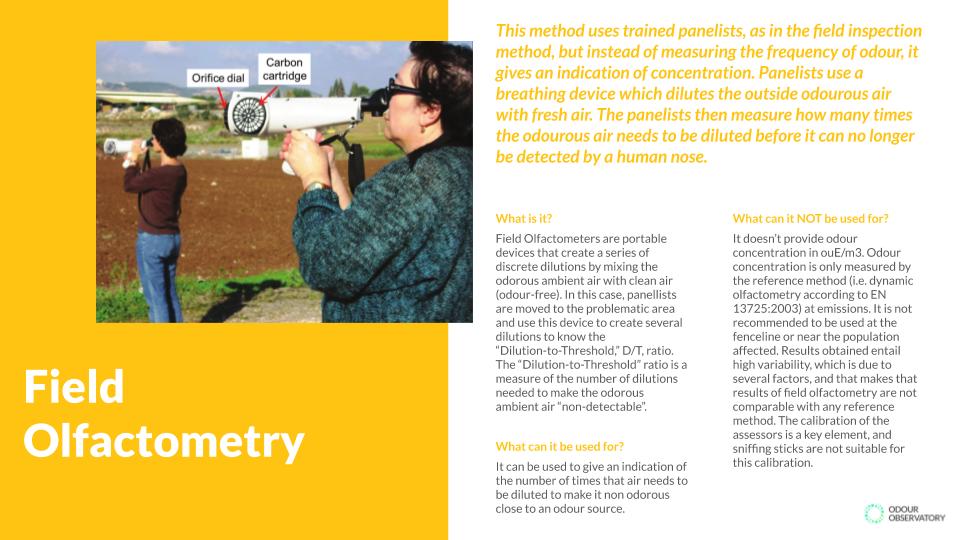 | Field Olfactometry | This summary sheet explains the method of field olfactometry, whereby trained panelists use a breathing device which dilutes the outside odourous air with fresh air. The panelists then measure how many times the odourous air needs to be diluted before it can no longer be detected by a human nose. | Educational, Measuring | educational measuring | |
 | Gas Chromatography Olfactometry | This summary sheet explains how the gas chromatography olfactometry method combines the senses of trained panelists and the technology gas chromatography to establish the correlation between specific chemicals and odour concentration. | Educational, Measuring | educational measuring | |
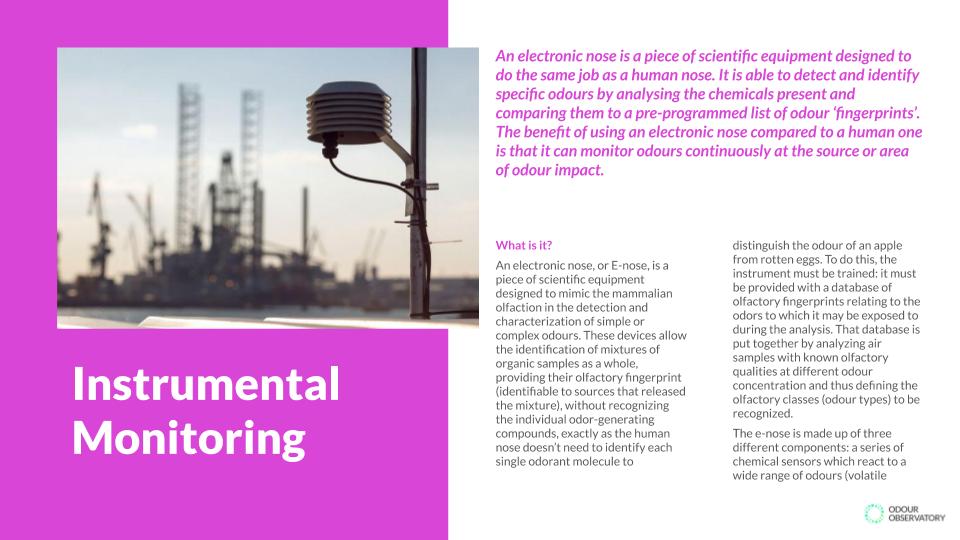 | Instrumental Monitoring | This summary sheet explains how an electronic nose can be used for the instrumental monitoring of odours. Compared to a human nose, the benefits of an electronic nose is that it can monitor odours continuously at the source or area of odour impact. | Educational, Measuring | educational measuring | |
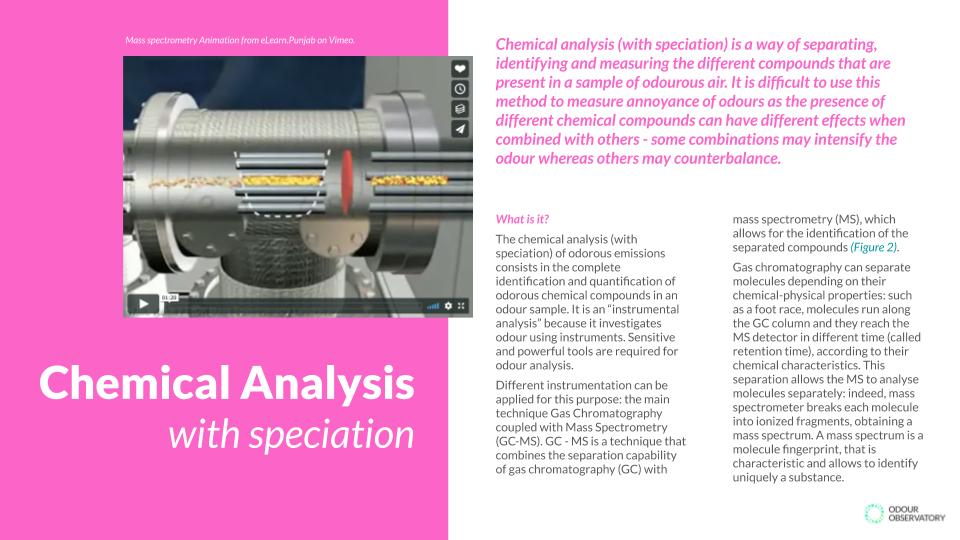 | Chemical Analysis with Speciation | This summary sheet aims to explain the role of chemical analysis with speciation in the measurement of odours. Chemical analysis with speciation is a way of separating, identifying and measuring the different compounds that are present in a sample of odourous air. | Educational, Measuring | educational measuring | |
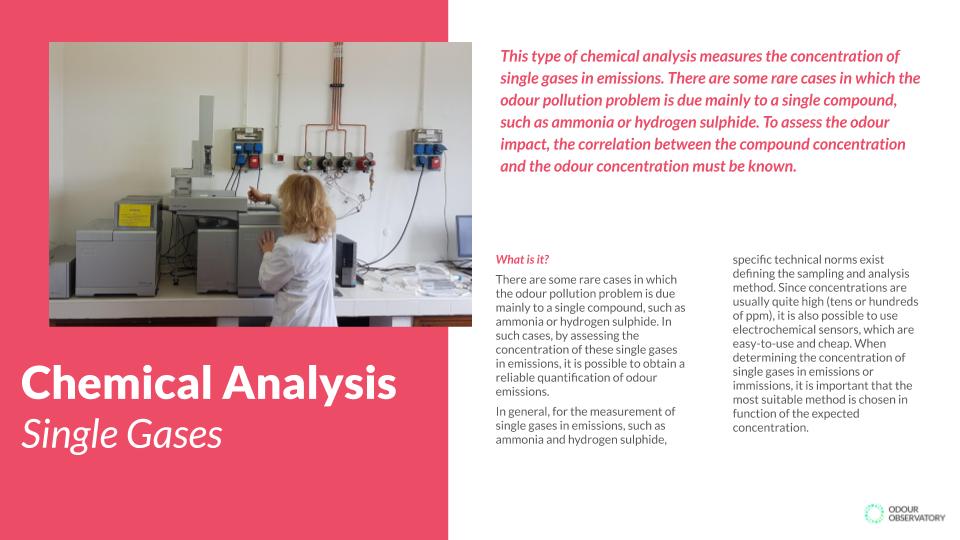 | Chemical Analysis - Single Gases | This summary sheet aims to explains the role of chemical analysis in the measurement of odours, with particular reference to single gases. | Educational, Measuring | educational measuring | |
 | Teachers Manual for Schools Programme | The teachers manual is designed for primary year students (7 to 11) and is built around 6 separate interactive lessons. The manual is organised into identically structured sections containing, for each lesson: objectives, learning outcomes, duration, list of concepts, materials needed, a teaching guidance and practices. At the end of the manual, there is an Appendix section with additional supporting material. | Educational | educational | |
 | Odour Impact Criteria in South American Regulations | This paper reviews odour impact criteria (OIC) applied in jurisdictions throughout South America. Particularly, the odour framework in countries such as Brazil, Chile and Colombia is presented. | Policies, Regulations, Research | policies regulations research | |
 | Nuisance smells: how councils deal with complaints | How councils assess and deal with nuisance odours from industrial, trade and business premises in the UK. | Educational, Policies | educational policies | |
 | A Review of National and International Odor Policy, Odor Measurement Technology, and Public Administration | This report presents the current state of the practice in odor regulation in the United States and selected countries around the world, reviews the regulatory needs in different territories and presents a regulatory framework that could be implemented in Minnesota. | Policies, Regulations, Research | policies regulations research | |
 | Are Environmental Odors Toxic? | Report on the toxicity of odours by the Agency for Toxic Substances and Disease Registry. | Educational | educational | |
 | Odor assessment tools and odor emissions in industrial processes | This study presents odour assessment tools and odour emissions in industrial processes. | Measuring, Research | measuring research | |
 | Olfactory Characterization of Typical Odorous Pollutants Part I: Relationship Between the Hedonic Tone and Odor Concentration | This paper focuses on the properties of odours and investigates the relationship between the hedonic tone and odour concentration. | Educational, Research | educational research | |
 | The Impact of Industrial Odors on the Subjective Well-Being of Communities in Colorado | This study assesses the impact of odors from industrial sources on the subjective well-being (SWB) of North Denver residents, and of four similar communities in Colorado for comparison. | Educational, Research | educational research | |
 | Air quality and odour evaluation on terrains characterized by a complicated odour emission profiles | This paper investigates methods for the evaluation of odor pollution on terrains characterized by complex emission profiles. | Measuring, Research | measuring research | |
 | A critical review of Regulations for the Control Of Odors | Critical review of regulations for the control of odors. | Regulations, Research | regulations research | |
 | Developing Odor Control Regulations: Guidelines and Considerations | Guidelines and considerations to develop odor control regulations. | Regulations | regulations | |
 | Odor Pollution Control Regulation and Measurement in China | This paper introduces odor pollution measurement and management in China which can be divided into national and local emission standard of odor pollutants. . | Measuring, Regulations, Research | measuring regulations research | |
 | A Review of 20 Years of Standardization of Odor Concentration Measurement by Dynamic Olfactometry in Europe | This paper reviews twenty years of development of standards for odor concentration measurement in Europe (1980 – 2000). | Measuring, Research | measuring research | |
 | Measurement of Odor Intensity by an Electronic Nose | This paper investigates the possibility of using electric noses (ENs) to measure odour intensity. | Measuring, Research | measuring research | |
 | Community Perception of Odor Pollution from the Landfill | This paper investigates community perceptions of odor pollution from a landfill in Malaysia. | Educational, Research | educational research | |
 | Air Pollution and Odor in Communities Near Industrial Swine Operations | This paper studies the impact of swine odor episodes reported by neighbors in North Carolina on daily-life activities. | Educational, Research | educational research | |
 | Odor Pollution in the Environment and the Detection Instrumentation | This paper examines the properties, sources and dispersion of odor pollution, and reviews odor monitoring instrumentation, odor emissions regulations and odor control technologies. | Educational, Measuring, Regulations, Research | educational measuring regulations research | |
 | Livestock Odors: Implications for Human Health and Well-Being | The purpose of this paper is to examine the potential effects of livestock odors on the health and well-being of neighbors. | Educational, Research | educational research | |
 | Guidance for Communities | This guidance document is designed to help communities who are affected by odour issues take steps to improve the situation. | Educational | educational | |
 | OdourCollect User Guide | A simple guide to show how to install an start using the OdourCollect app. | Measuring | measuring | |
 | DNOSES Policy Brief in Italian | L’inquinamento olfattivo è strettamente correlato alle problematiche ambientali e sanitarie, pertanto, necessita di una regolamentazione più rigorosa in Europa. Il coinvolgimento dei cittadini nei processi di controllo e gestione degli odori è vantaggioso per tutte le parti interessate, in quanto promuove l’educazione scientifica, migliora le relazioni e aumenta la fiducia nelle autorità pubbliche | Policies | policies | |
 | Combination of field inspection and dispersion modelling to estimate odour emissions from an Italian landfill | In the case of landfills, the determination of odour emissions is particularly complex. Up to now, no universally Odour emission rate accepted methodology for sampling and assessing emissions from landfill surfaces has been established. Besides, Odour impact assessment the dependence of such emissions from some crucial environmental variables, such as wind speed, has not been univocally defined yet. In this study, odour dispersion modelling and plume inspections by human assessors were combined in order to estimate the odour emissions from a landfill in Southern Italy. | Measuring, Research | measuring research | |
 | A review of odour impact criteria in selected countries around the world | Exposure to environmental odour can result in annoyance, health effects and depreciation of property values. Therefore, many jurisdictions classify odour as an atmospheric pollutant and regulate emissions and/or impacts from odour generating activities at a national, state or municipal level. In this work, a critical review of odour regulations in selected jurisdictions of 28 countries is presented. | Measuring, Regulations, Research | measuring regulations research | |
 | Assessment of odour annoyance with questionnaires | Gerhard Schleenstein presents this introductory course for Basic Training on Odour pollution using questionnaires to assess the level of odour annoyance in Chile | Measuring | measuring | |
 | Odour regulation and odour impact criteria around the world | Carlos Diaz presents this introductory course for Basic Training on Odour pollution | Educational, Regulations | educational regulations | |
 | D-NOSES course on odour pollution (MOOC for general public) | This MOOC offers open access to knowledge, insights and good practices on the issue of odour pollution and contributes to supporting citizen engagement in odour monitoring processes. Learners will generate an understanding of the causes of odour pollution and how it affects lives, whilst exploring some of the key environmental, social/health and economic impacts of odour pollution. | Educational | educational | |
 | DNOSES Policy Brief | Odour pollution is linked to environmental and health issues and therefore needs to be more closely regulated in Europe. | Policies | policies |
- Happy or unhappy with the Odour Observatory? Tell us here!
